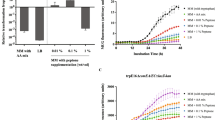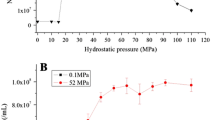Abstract
In appropriate environments containing 2-monochloropropionic acid (2MCPA), mutations in a population of nondehalogenatingPseudomonas putida, strain PP40-040 (parent population), resulted in the formation of 2mcpa+ papillae as a result of the decryptification of adehII gene. Increasing the size of the parent population, for example by increasing the availability of a metabolizable substrate such as succinate or lactate, increased the number of 2mcpa+ papillae formed because there were more parent cells available for mutation to the 2mcpa+ phenotype. The presence of a dehalogenating population, such asP. putida strain PP3, in close proximity to the non-dehalogenating population, also increased the number of 2mcpa+ papillae formed. This was due to the excretion of dehalogenases into the growth medium, which caused localized dehalogenation of the available 2MCPA, yielding a metabolizable substrate. This substrate stimulated the growth of the non-dehalogenating population, in turn increasing the number of 2mcpa+ papillae formed. Barriers, such as dialysis membranes, which prevented the excretion of the dehalogenases into the growth medium, prevented the stimulation of 2mcpa+ papillae formation by preventing release of metabolizable substrates from 2MCPA breakdown. Cell-free extracts (CFE) from dehalogenase-producing populations had a similar effect for the same reason. CFE without dehalogenase activity or in which the dehalogenase activity had been destroyed by heating failed to stimulate parent population growth and 2mcpa+ papillae formation. In the case ofPseudomonas putida strain PP3, which carries an easily transposed dehalogenase-encoding transposon, treatment of CFE with DNAase eliminated an additional factor involved in the formation of 2mcpa+ papillae.
Similar content being viewed by others
References
Hope, S.J. & Slater, J.H. 1995 Cryptic dehalogenase and chloroamidase genes inPseudomonas putida and the influence of environmental conditions on their expression.Archives for Microbiology, in press.
SeniorE., BullA.T. & SlaterJ.H. 1976 Enzyme evolution in a microbial community growing on the herbicide Dalapon.Nature 263, 476–479.
SlaterJ.H. 1994 Microbial dehalogenation of haloaliphatic compounds. InBiochemistry of Microbial Degradation, ed RatledgeC., pp. 379–421. Dordrecht: Kluwer Academic.
SlaterJ.H., LovattD., WeightmanA.J., SeniorE. & BullA.T. 1979 The growth ofPseudomonas putida on chlorinated aliphatic acids and its dehalogenating activity.Journal of General Microbiology 114, 125–136.
SlaterJ.H., WeightmanA.J. & HallB.G. 1985 Dehalogenase genes ofPseudomonas putida PP3 on chromosomally located transposable elements.Molecular Biology and Evolution 2, 557–567.
Thomas, A.W. 1990 Analysis of a mobile genetic element fromPseudomonas putida which encodes dehalogenase functions. PhD Thesis, University of Wales, Cardiff, UK.
ThomasA.W., LewingtonJ., HopeS., ToppingA.W., WeightmanA.J. & SlaterJ.H. 1992c Environmentally directed mutations in the dehalogenase system ofPseudomonas putida strain PP3.Archives for Microbiology 158, 176–182.
ThomasA.W., SlaterJ.H. & WeightmanA.J. 1992a The dehalogenase genedehI fromPseudomonas putida strain PP3 is carried on an unusual mobile genetic element designatedDEH.Journal of Bacteriology 174, 1932–1940.
ThomasA.W., ToppingA.W., SlaterJ.H. & WeightmanA. J. 1992b Localisation and functional analysis of structural and regulatory dehalogenase genes carried onDEH fromPseudomonas putida strain PP3.Journal of Bacteriology 174, 1941–1947.
WeightmanA.J. & SlaterJ.H. 1980 Selection ofPseudomonas putida strains with elevated dehalogenase activity by continuous culture growth on chlorinated alkanoic acids.Journal of General Microbiology 121, 187–193.
WeightmanA.J., WeightmanA.L. & SlaterJ.H. 1985 Toxic effects of chlorinated and brominated alkanoic acids onPseudomonas putida PP3: selection at high frequencies of mutations in gene encoding dehalogenases.Applied and Environmental Microbiology 49, 1494–1501.
Author information
Authors and Affiliations
Additional information
The authors are with the School of Pure and Applied Biology, University of Wales-Cardiff, P.O. Box 915, Cardiff CF1 3TL, UK
Rights and permissions
About this article
Cite this article
Slater, J.H., Hope, S.J. Interactions between populations ofPseudomonas putida leading to the expression of a cryptic dehalogenase gene (dehll). World J Microbiol Biotechnol 11, 186–192 (1995). https://doi.org/10.1007/BF00704646
Received:
Accepted:
Issue Date:
DOI: https://doi.org/10.1007/BF00704646




